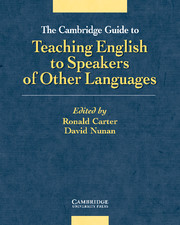Book contents
- Frontmatter
- Contents
- List of figures
- List of abbreviations
- Acknowledgements
- List of contributors
- Introduction
- Chapter 1 Listening
- Chapter 2 Speaking
- Chapter 3 Reading
- Chapter 4 Writing
- Chapter 5 Grammar
- Chapter 6 Vocabulary
- Chapter 7 Discourse
- Chapter 8 Pronunciation
- Chapter 9 Materials development
- Chapter 10 Second language teacher education
- Chapter 11 Psycholinguistics
- Chapter 12 Second language acquisition
- Chapter 13 Bilingualism
- Chapter 14 Sociolinguistics
- Chapter 15 Computer-assisted language learning
- Chapter 16 Observation
- Chapter 17 Classroom interaction
- Chapter 18 English for academic purposes
- Chapter 19 English for specific purposes
- Chapter 20 Assessment
- Chapter 21 Evaluation
- Chapter 22 Syllabus design
- Chapter 23 Language awareness
- Chapter 24 Language learning strategies
- Chapter 25 Task-based language learning
- Chapter 26 Literature in the language classroom
- Chapter 27 Genre
- Chapter 28 Programme management
- Chapter 29 Intercultural communication
- Chapter 30 On-line communication
- Postscript: The ideology of TESOL
- Glossary
- References
- Index
Chapter 4 - Writing
Published online by Cambridge University Press: 07 September 2010
- Frontmatter
- Contents
- List of figures
- List of abbreviations
- Acknowledgements
- List of contributors
- Introduction
- Chapter 1 Listening
- Chapter 2 Speaking
- Chapter 3 Reading
- Chapter 4 Writing
- Chapter 5 Grammar
- Chapter 6 Vocabulary
- Chapter 7 Discourse
- Chapter 8 Pronunciation
- Chapter 9 Materials development
- Chapter 10 Second language teacher education
- Chapter 11 Psycholinguistics
- Chapter 12 Second language acquisition
- Chapter 13 Bilingualism
- Chapter 14 Sociolinguistics
- Chapter 15 Computer-assisted language learning
- Chapter 16 Observation
- Chapter 17 Classroom interaction
- Chapter 18 English for academic purposes
- Chapter 19 English for specific purposes
- Chapter 20 Assessment
- Chapter 21 Evaluation
- Chapter 22 Syllabus design
- Chapter 23 Language awareness
- Chapter 24 Language learning strategies
- Chapter 25 Task-based language learning
- Chapter 26 Literature in the language classroom
- Chapter 27 Genre
- Chapter 28 Programme management
- Chapter 29 Intercultural communication
- Chapter 30 On-line communication
- Postscript: The ideology of TESOL
- Glossary
- References
- Index
Summary
Introduction
Teaching English second language (L2) writing differs from teaching other language skills in two ways. First, even as late as the 1970s, L2 writing was not viewed as a language skill to be taught to learners. Instead, it was used as a support skill in language learning to, for example, practise handwriting, write answers to grammar and reading exercises, and write dictation. In fact, while graduate programmes in TESOL regularly offered courses in other skill areas, virtually no coursework was available in teaching L2 writing. Second, as the theory and practice of L2 composition teaching gradually developed, it followed the path of US native English speaker (NES) composition theory. Only recently has English L2 composition theory and pedagogy begun to offer English first language (L1) researchers and teachers insights and pedagogical practices (Silva et al. 1997). This chapter focuses mainly on L2 academic writing, although broader issues are also highlighted.
Background
In the 1970s many English L2 language programme writing classes were, in reality, grammar courses. Students copied sentences or short pieces of discourse, making discrete changes in person or tense. The teaching philosophy grew directly out of the audiolingual method: students were taught incrementally, error was prevented and accuracy was expected to arise out of practice with structures. In the early 1980s, as teachers became more aware of current practices in NES composition, there was a shift from strictly controlled writing to guided writing: writing was limited to structuring sentences, often in direct answers to questions, or by combining sentences – the result of which looked like a short piece of discourse.
- Type
- Chapter
- Information
- Publisher: Cambridge University PressPrint publication year: 2001
- 7
- Cited by



